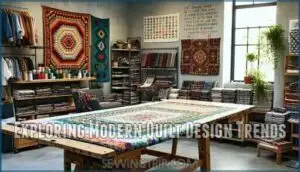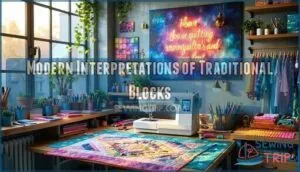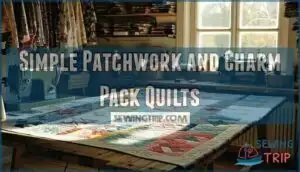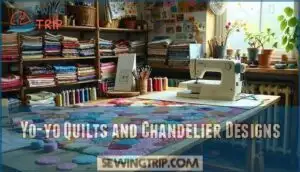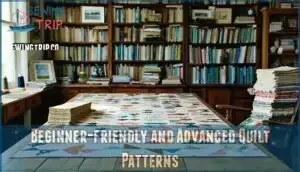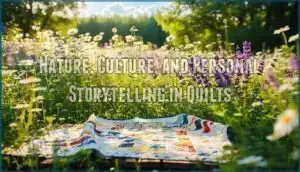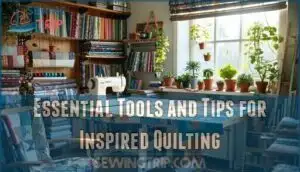This site is supported by our readers. We may earn a commission, at no cost to you, if you purchase through links.
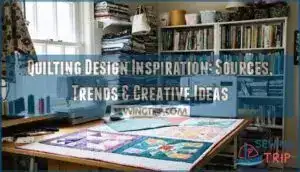
The difference between a quilt that sings and one that simply exists often comes down to where you look for ideas. Fresh quilting design inspiration doesn’t require reinventing the wheel; it lives in unexpected places, from heritage techniques reimagined through modern lenses to nature’s geometries translated into bold color palettes.
Your next pivotal design might emerge from a podcast conversation, a digitally printed custom fabric, or the satisfying challenge of breaking traditional rules with improvisational piecing.
Table Of Contents
Key Takeaways
- Quilting inspiration lives in unexpected places—heritage techniques reimagined through modern lenses, nature’s geometries, bold rule-breaking with improvisational piecing, and digital tools like custom fabric printing that turn your sketches into yardage.
- Modern quilting thrives on breaking tradition through saturated colors, sharp geometric patterns, sustainable upcycled materials, and tech-enhanced fabrics that push quilts beyond cotton into healthcare and artistic frontiers.
- Your most powerful design fuel comes from personal storytelling—memory quilts built from family heirlooms, travel snapshots translated into color palettes, and cultural heritage stitched into narrative panels that speak across generations.
- Real quilting momentum requires community connection through online forums, local meetups, and social platforms where troubleshooting becomes collaborative and bold fabric choices get validated by makers who understand your creative vision.
Fresh Sources for Quilting Design Inspiration
You’ve got more inspiration at your fingertips than ever before. Quilting magazines, podcasts, blogs, and social media each offer something different—whether it’s techniques, fresh patterns, or a community that gets what you’re working toward.
Here’s where to look when you need that creative spark.
Quilting Magazines, Podcasts, and TV Shows
When you’re hunting for fresh quilting ideas, magazines, podcasts, and TV shows deliver a steady stream of patterns, techniques, and stories that can spark your next masterpiece. Quilting Daily and Quilt Inspiration offer print and digital editions packed with projects, while Quilting Arts and Quiltmaker showcase contemporary designs. Tune into podcasts for quilt interviews with inspiring guests, or watch TV hosts demonstrate hands-on techniques.
- Magazine reviews provide seasonal project collections and material recommendations
- Podcast guests share behind-the-scenes stories from the quilting community
- TV hosts demonstrate piecing methods and troubleshoot common challenges
- Quilting Arts explores experimental approaches to color and composition
- Quiltmaker features beginner-friendly patterns alongside sophisticated techniques
Influential Quilting Blogs and Online Communities
Beyond magazines and broadcasts, quilting blogs and online communities keep you connected to thousands of makers who share patterns, host workshops, and challenge your skills. Quilting Daily leads with 293,700 followers, while Diary of a Quilter offers 75-plus beginner tutorials each year.
Forums like the American Quilt Study Group bring together 5,100 members for virtual workshops, and monthly quilt-alongs post a 65% completion rate. You’ll find design inspiration, community engagement, and real-time troubleshooting in these spaces.
For more information on quilting resources, visit websites with quilting daily blogs to explore various patterns and tutorials.
Social Media Platforms for Quilt Sharing
Instagram and Pinterest turn your phone into a gallery where quilters post daily work, swap fabric combos, and run hashtag challenges that pull you into global conversations.
TikTok and YouTube show real-time piecing demos and color auditions, while Facebook groups host weekly challenges that connect quilter networks across time zones.
These digital galleries let you bookmark ideas, join online forums, and tap into quilting lifestyle and culture without leaving your couch.
Quilt Shows, Exhibitions, and Challenges
After scrolling through digital feeds, nothing beats standing in front of a full-size quilt where you can see each stitch, feel the weight of the batting, and talk shop with the maker who pinned it to the wall. QuiltCon 2024 and regional exhibitions let you study award winners up close while judging criteria sharpen your design eye:
- Quilt competitions push technical skill and modern quilting innovation.
- Exhibition tips help you prep challenge entries for show judging.
- Curator talks decode quilt design inspiration behind each piece.
- Vendor booths preview fabric lines before they hit stores.
- Networking sessions connect you with collaborators who share your aesthetic.
Exploring Modern Quilt Design Trends
Modern quilting isn’t just following the rules—it’s rewriting them. Today’s quilters are mixing unexpected colors, experimenting with new materials, and finding creative ways to make their work more sustainable.
Here’s what’s shaping the contemporary quilt landscape right now.
Bold Colors and Geometric Patterns
Modern quilts don’t whisper—they shout with saturated hues and sharp-edged shapes that break every rule your grandmother’s generation followed. Think electric tangerine colliding with cobalt, triangles slicing through negative space—this is contemporary art quilting at its most unapologetic.
Pattern mixing and vibrant textiles drive modern aesthetics, where color theory becomes your playground and geometric shapes your vocabulary. Quilt design inspiration now celebrates bold modern quilting that demands attention.
Innovative Materials and Techniques
You can push beyond cotton when you discover smart fabrics with embedded sensors—these tech-enhanced textiles now capture a 3.2% market share and bring contemporary art quilting into healthcare spaces. Sophisticated machinery, like automated cutting tools, slashes waste by 15-20%, while digital printing lets you create custom designs that reduce your environmental footprint by 16%.
Over 70% of quilters now use design software for precision work, and materials like silk, denim, and metallic fabrics surged 21% between 2021 and 2024—proof that sustainable textiles and bold experimentation define modern fabric design and creative expression.
The growing demand for quilts is driven by trends in the quilt market research that focus on cutting-edge materials and techniques.
Sustainability and Upcycled Fabrics
Conscious choices reshape your quilting lifestyle when you embrace eco-friendly materials and repurposed textiles. Historical quilters pioneered upcycled fabrics using flour sacks and worn clothing—now that wisdom returns as green quilting tips gain momentum.
This textile art and design movement offers quilt inspiration through:
- Vintage sheets and button-down shirts for large-yardage sustainable quilting projects
- Thrifted materials integrated into each green quilt to counter fast fashion waste
- Water conservation—upcycled fabric crafts eliminate the 2,700 litres needed per metre of new fabric
- Reduced landfill impact—diverting textiles from the 17 million tons entering U.S. landfills annually
Digital Fabric Printing and Customization
Your imagination becomes a printable reality when digital fabric printing technology turns sketches, photographs, or vector art into yards of custom cloth.
Print techniques deliver intricate fabric design without screens or setup costs—perfect for one-of-a-kind textile art and design projects. Color matching software ensures your custom fabrics reflect your vision, transforming fabric selection into a creative playground for bold quilt design.
| Advantage | Impact on Your Fabric Art |
|---|---|
| Design Freedom | Print any pattern—from watercolor florals to geometric digital prints |
| Precision | Color matching technology captures exact hues for cohesive fabric choices |
| Small Runs | Order single yards without minimums, ideal for experimental weaving projects |
Creative Quilt Patterns and Project Ideas
The right pattern can turn your next quilt from a simple project into something that really speaks to you. Whether you’re drawn to reimagined classics, quick-piece designs, or unexpected constructions, there’s a pattern out there that fits your style and skill level.
Here’s a look at some creative directions worth exploring.
Modern Interpretations of Traditional Blocks
Traditional quilt blocks don’t have to stay stuck in the past—they’re perfect canvases for your own creative twist. Whether you’re playing with unexpected color combinations, scaling patterns in bold new ways, or mixing heritage motifs with contemporary fabrics, there’s room for innovation.
Think about a Bear Paw block in neon gradients or a Wild Goose Chase reimagined with digital prints. These heritage fusion approaches breathe fresh energy into classic patchwork while honoring the traditional quilting techniques that built this craft.
Simple Patchwork and Charm Pack Quilts
If you’re short on time or just getting your feet wet, charm packs and simple patchwork quilts are your best friends—pre-cut squares take the guesswork out of fabric choices and let you jump straight into sewing. These sewing shortcuts turn patchwork basics into finished tops in no time.
Try these charm pack ideas:
- Four-patch blocks using contrasting fabric selection tips
- Simple nine-patch layouts with alternating squares
- Strip-set patchwork for fast quilt block patterns
- Scrappy layouts that celebrate quilting inspiration through variety
Yo-yo Quilts and Chandelier Designs
Yo-yo quilts break every rule you just learned—no sewing squares together, no seams to match—just gathered fabric circles stitched side by side for a playful, dimensional look that’s equal parts vintage charm and modern whimsy. Chandelier patterns flip the script with vertical cascades of shapes that draw the eye downward, mixing simple geometry with modern design elements for dramatic impact.
Both approaches welcome quilt embellishments and offer fresh quilting inspiration. Yo-yo quilt designs let you experiment with fabric combinations without precision piecing, while chandelier quilt patterns reward bold color placement and thoughtful sewing tips that keep your blocks aligned.
| Yo-yo Techniques | Chandelier Patterns | Fabric Choices |
|---|---|---|
| Hand-gathered circles | Vertical drop layouts | Cotton prints work best |
| Side-by-side joining | Geometric repetition | Batiks add depth |
| Dimensional texture | Negative space focus | Scraps create variety |
| Vintage-inspired finish | Contemporary structure | Bold solids pop |
Beginner-friendly and Advanced Quilt Patterns
Whether you’re cutting your first quilt square or pushing the limits of complex piecing, pattern choice makes or breaks your momentum—pick one that matches where you’re at, not where you think you should be. Start with these:
- Nine-patch blocks teach patchwork techniques without overwhelming your quilting tools
- Half-square triangles build confidence in fabric selection and seam accuracy
- Log cabin designs introduce beginner quilt patterns with forgiving construction
- Improvisational piecing lets experienced quilters explore modern quilt designs freely
- Foundation paper piecing challenges your quilting techniques with intricate quilt block designs
Your sewing patterns grow with you—honor that.
Nature, Culture, and Personal Storytelling in Quilts
Quilts tell stories that words can’t capture. They pull from the world around you—wildflowers in a meadow, your grandmother’s favorite color, the rhythm of a city you once called home.
Let’s look at how nature, heritage, and your own life can shape quilts that feel alive with meaning.
Nature-inspired Motifs and Classic Patterns
Quilts have borrowed from the natural world for centuries, and patterns like Bear Paw, Dove in the Window, and Sunflower prove that bringing the outdoors into your work never goes out of style.
You’ll find leaf motifs and bird designs woven into traditional patchwork, while floral patterns and botanical prints offer endless quilt inspiration.
These nature scenes translate beautifully through various quilting techniques, giving you fresh quilt design ideas that honor timeless quilt patterns.
Heritage Techniques in Contemporary Quilting
Hand-quilting and appliqué aren’t just nods to the past—they’re creative tools that ground your work in cultural preservation and heritage stitching. Over 70% of quilters now blend vintage blocks with modern fabrics, turning quilt restoration insights into fresh quilting techniques. You’ll see traditional embellishments reimagined through contemporary quilting arts, proving that old-world methods still spark bold new quilt patterns.
- Hand-stitched details bring warmth and soul to machine-pieced tops
- Kantha and sashiko workshops connect you to global quilting traditions
- Hybrid construction lets you honor the past while making something entirely yours
Quilts as Narrative and Cultural Artifacts
When you stitch quilt storytelling into your work, you’re joining a lineage where more than 60% of documented quilts carry narrative panels that speak across generations.
When you stitch storytelling into your work, you join a lineage where over 60% of documented quilts carry narrative panels that speak across generations
Cultural heritage lives in every block—from the 700+ Gee’s Bend quilts celebrating resilience to improvisational African designs that turn textile art into stitched art without words.
Quilt preservation efforts now digitize thousands of these pieces, fueling art quilting and quilting arts communities hungry for artistic expression and quilt inspiration rooted in real stories.
Personal Experiences as Design Inspiration
Your memories—the ones that catch you off guard at the fabric store or flash through your mind mid-stitch—hold more design power than any pattern book ever could. Life stories and childhood influences fuel memory quilts that transform emotional expression into fabric:
- A grandmother’s apron print becomes your personal symbols
- Travel snapshots inspire modern quilting inspiration through color palettes
- Family heirlooms guide quilt design ideas with historical texture
- Journal entries translate into creative quilting projects using quilting arts techniques
This quilt inspiration makes your work irreplaceable.
Essential Tools and Tips for Inspired Quilting
Having inspiration is one thing—turning it into a finished quilt is another. The right tools, techniques, and community connections can transform your creative vision into something you can wrap yourself in.
Here’s what you need to make your quilting ideas real.
Must-have Quilting Resources and Magazines
The right magazine or resource can feel like having a trusted mentor guiding your hands through every cut, stitch, and creative decision. Publications like Quilting Arts, Quiltmaker, and McCall’s Quilting deliver fresh quilt patterns, fabric selection advice, and creative quilting projects straight to your workspace. They’re goldmines for quilting techniques and tips, connecting you to vibrant quilting communities while offering essential sewing tools guidance.
| Magazine | Best For |
|---|---|
| Quilting Arts | Contemporary art quilting and bold creativity |
| Quiltmaker | Traditional blocks with modern twists |
| Quick + Easy Quilts | Fast, beginner-friendly projects |
| Fons & Porter | Free patterns and foundational skills |
Techniques for Piecing, Appliqué, and Handwork
Mastering piecing, appliqué, and handwork isn’t about flawlessness—it’s about finding the rhythm between your fabric, thread, and fingers until each stitch becomes second nature.
Start with these fabric manipulation foundations:
- Piecing tips: Press seams consistently and use a quarter-inch foot for accurate patchwork construction
- Appliqué methods: Try needle-turn or fusible techniques to secure shapes onto your quilt top
- Hand quilting: Develop your stitch techniques with running stitches, working through all three layers for texture and durability
These quilting techniques build confidence and give you control over every creative decision.
Calculating Fabric Needs and Choosing Materials
Getting your fabric quantities right from the start saves you from that sinking feeling when you’re three blocks short or drowning in yards you’ll never use. Calculate yardage by counting your quilt pattern’s individual pieces, adding seam allowances, then tossing in 10-15% extra for patchwork mishaps.
When choosing fabric, think beyond color coordination—consider thread weight, batting options that match your quilt’s purpose, and how different textures play together in your design.
Connecting With The Quilting Community for Support
Real quilters don’t work in isolation—they thrive on swapping tips, troubleshooting together, and celebrating finished projects with people who actually get why you spent six months on a single quilt. Jump into Quilting Forums and Online Groups where sewing and crafting veterans share quilting techniques with beginners daily.
Three ways your crafting community fuels your creative fire:
- Quilter Meetups and Community Events turn technical struggles into shared victories—someone’s already solved your binding disaster.
- Social Sharing on platforms dedicated to quilting communities sparks fresh ideas you’d never discover alone.
- Real-time feedback from fellow makers validates your bold fabric choices and pushes your design boundaries further.
Frequently Asked Questions (FAQs)
Where can I find more quilt inspiration?
Believe it or not, inspiration doesn’t always strike when you’re staring at fabric—sometimes the best quilt design ideas come from stepping away from your machine entirely.
Online forums and quilting books offer endless modern quilting inspiration, while quilt shows and exhibitions let you experience modern quilt designs in person, sparking fresh creativity.
Why are modern quilt designs so popular?
Modern quilt designs break free from rigid tradition, letting you play with bold colors, unexpected patterns, and fresh materials.
Contemporary styles invite artistic expression and design freedom, making modern quilts feel personal, creative, and genuinely yours.
What are modern quilt ideas?
Picture modern quilts as jazz riffs on traditional hymns—bold colors clash beautifully, geometric patterns break rules, and upcycled fabrics tell fresh stories.
You’ll find minimalist designs, improvisational piecing, and digital prints creating textile designs that push boundaries while honoring heritage techniques.
What is a Prairie Point quilt?
Prairie Points are folded fabric triangles stitched into quilt edges, creating a dimensional, sawtooth border. You fold squares diagonally, layer them along your quilt binding, then secure them during edge finishing—adding texture and visual interest to traditional patchwork or modern quilt design.
Why do modern quilters make quilts?
Creating with fabric and thread offers Emotional Expression and a Creative Outlet that nurtures Personal Growth. You’re stitching together stories, crafting Family Heirlooms, and experiencing Therapeutic Benefits through each modern quilt.
Quilting Techniques transform raw materials into Quilt Design that reflects your voice.
Why should you choose a quilt pattern?
Choosing a quilt pattern gives you a roadmap for fabric choice, color schemes, and design themes. It clarifies pattern complexity before you cut, helping you match your skill level and vision while keeping patchwork organized and quilt making intentional.
How do I develop my own unique quilting style?
Your artistic voice awakens when you experiment fearlessly and track your creative projects in a quilt journal.
Embrace style evolution through personal expression and creative freedom that honors your unique journey.
What color theory principles work best for quilts?
Color Harmony and Contrast Theory form the foundation. Complementary hues create visual pop, while analogous colors bring cohesion.
Balance saturation and use tint shading strategically—high contrast draws the eye, subtle gradations create depth in Quilt Patterns and Art Quilting designs.
How can I translate non-quilting art into patterns?
Think of Art Quilting as bridging worlds—transforming paintings, photographs, or architecture into Textile Arts and Crafts through Visual Interpretation.
Break imagery into shapes, isolate color blocks, and map dominant lines into Creative Translation grids.
This Artistic Conversion turns any Inspirational Mapping into striking Quilt Designs.
Where do quilters find vintage fabric for projects?
You’ll find vintage fabric at thrift stores, estate sales, and antique shops. Online marketplaces connect you with sellers offering authentic prints.
These fabrics bring character to patchwork projects and let you explore traditional quilting techniques with genuine materials.
Conclusion
Tradition anchors your hands while innovation pulls your imagination forward—and that tension fuels every compelling quilt. The quilting design inspiration you seek isn’t hiding in one perfect source; it’s scattered across podcasts, heritage techniques, nature’s geometry, and the quiet rebellion of breaking rules you once followed religiously.
Your next discovery won’t arrive fully formed. It’ll emerge when you stop waiting for permission and start stitching together the unexpected—bold color against classic block, digital print beside hand-stitched appliqué, your story translated into fabric that refuses to fade into the background.
- https://craftindustryalliance.org/the-size-of-the-quilting-market-quilting-trends-survey-results-2025/
- https://fabshopnet.com/wp-content/uploads/downloads/qia_summary.pdf
- https://www.stringandstory.com/blog/fiveandsixcolorquilts
- https://www.bigwes.com/quilt-blog/current-trends-in-quilting-whats-hot-in-2024/
- https://www.nps.gov/home/planyourvisit/quilt-discovery-experience.htm

